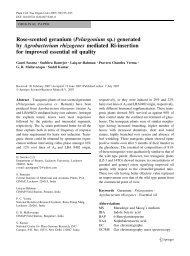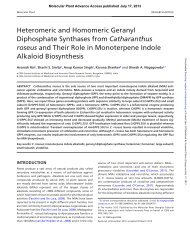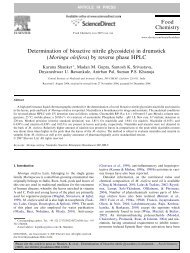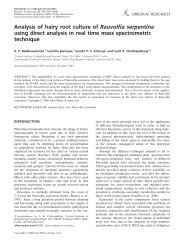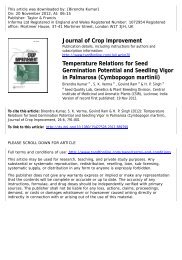Volume 2. Issue 1. ISSN 1555-9475 (online) www ... - CIMAP Staff
Volume 2. Issue 1. ISSN 1555-9475 (online) www ... - CIMAP Staff
Volume 2. Issue 1. ISSN 1555-9475 (online) www ... - CIMAP Staff
- No tags were found...
Create successful ePaper yourself
Turn your PDF publications into a flip-book with our unique Google optimized e-Paper software.
<strong>Volume</strong> <strong>2.</strong> <strong>Issue</strong> <strong>1.</strong> Pages 1-116. 2007<strong>ISSN</strong> 1934-578X (printed); <strong>ISSN</strong> <strong>1555</strong>-<strong>9475</strong> (<strong>online</strong>)<strong>www</strong>.naturalproduct.us
NPCNatural Product CommunicationsEDITOR-IN-CHIEFDR. PAWAN K AGRAWALNatural Product Inc.7963, Anderson Park Lane,Westerville, Ohio, 43081 USAagrawal@naturalproduct.usEDITORSPROFESSOR GERALD BLUNDENThe School of Pharmacy & Biomedical Sciences,University of Portsmouth,Portsmouth, PO1 2DT U.K.axuf64@dsl.pipex.comPROFESSOR ALESSANDRA BRACADipartimento di Chimica Bioorganicae Biofarmacia,Universita di Pisa,via Bonanno 33, 56126 Pisa, ItalyEmail: braca@farm.unipi.itPROFESSOR DEAN GUOState Key Laboratory of Natural and Biomimetic Drugs,School of Pharmaceutical Sciences,Peking University,Beijing 100083, Chinagda5958@163.comPROFESSOR ERNST HASLINGERInstitute of Pharmaceutical Chemistry,University of Graz,A-8010 Graz, AustriaErnst.Haslinger@uni-graz.atPROFESSOR J. ALBERTO MARCODepartamento de Quimica Organica,Universidade de Valencia,E-46100 Burjassot, Valencia, Spainalberto.marco@uv.esPROFESSOR YOSHIHIRO MIMAKISchool of Pharmacy,Tokyo University of Pharmacy and Life Sciences,Horinouchi 1432-1, Hachioji, Tokyo 192-0392, Japanmimakiy@ps.toyaku.ac.jpPROFESSOR STEPHEN G. PYNEDepartment of ChemistryUniversity of WollongongWollongong, New South Wales, 2522, Australiaspyne@uow.edu.auPROFESSOR M. G. REINECKEDepartment of Chemistry,Texas Christian University,Forts Worth, TX 76129, USAm.reinecke@tcu.eduPROFESSOR YASUHIRO TEZUKAInstitute of Natural MedicineToyama Medical and Pharmaceutical University,2630-Sugitani, Toyama 930-0194, Japontezuka@ms.toyama-mpu.ac.jpADVISORY BOARDProf. Oyvind AndersenBergen, NorwayProf. Yoshinori AsakawaTokushima, JapanProf. Bruno BottaRoma, ItalyProf. Carlos Cerda-Garcia-RojasMexico city, MexicoProf. Ioanna ChinouAthens, GreeceProf. Josep CollBarcelona, SpainProf. Geoffrey CordellChicago, IL, USAProf. Samuel DanishefskyNew York, NY, USADr. Biswanath DasHyderabad, IndiaProf. A.A. Leslie GunatilakaTucson, AZ, USAProf. Stephen HanessianMontreal, CanadaProf. Michael HeinrichLondon, UKProf. Kurt HostettmannLausanne, SwitzerlandProf. Martin A. Iglesias ArteagaMexico, D. F, MexicoProf. Jerzy JaroszewskiCopenhagen, DenmarkProf. Teodoro KaufmanRosario, ArgentinaProf. Norbert De KimpeGent, BelgiumProf. Hartmut LaatschGottingen, GermanyProf. Marie Lacaille-DuboisDijon, FranceProf. Shoei-Sheng LeeTaipei, TaiwanProf. Chun-Nan LinKaohsiung, chinaProf. Francisco MaciasCadiz, SpainProf. Anita MarsaioliCampinas, BrazilProf. Rachel MataMexico D. F., MexicoProf. Imre MatheSzeged, HungaryProf. Joseph MichaelJohannesburg, South AfricaProf. Ermino MuranoTrieste, ItalyProf. Virinder ParmarDelhi, IndiaProf. Luc PietersAntwerp, BelgiumProf. Om PrakashManhattan, KS, USAProf. Peter ProkschDüsseldorf, GermanyProf. William ReynoldsToronto, CanadaProf. Raffaele RiccioSalerno, ItalyProf. Ricardo RigueraSantiago de Compostela, SpainProf. Satyajit SarkerColeraine, UKProf. William N. SetzerHuntsville, AL, USAProf. Monique SimmondsRichmond, UKProf. Valentin StonikVladivostok, RussiaProf. Hermann StuppnerInnsbruck, AustriaProf. Apichart SuksamrarnBangkock, ThailandProf. Hiromitsu TakayamaChiba, JapanProf. Peter G. WatermanLismore, AustraliaProf. Paul WenderStanford, USAINFORMATION FOR AUTHORSFull details of how to submit a manuscript for publication in Natural Product Communications are given in Information for Authors on our Web sitehttp://<strong>www</strong>.naturalproduct.us.Authors may reproduce/republish portions of their published contribution without seeking permission from NPC, provided that any such republication isaccompanied by an acknowledgment (original citation)-Reproduced by permission of Natural Product Communications. Any unauthorized reproduction,transmission or storage may result in either civil or criminal liability.The publication of each of the articles contained herein is protected by copyright. Except as allowed under national “fair use” laws, copying is not permitted byany means or for any purpose, such as for distribution to any third party (whether by sale, loan, gift, or otherwise); as agent (express or implied) of any thirdparty; for purposes of advertising or promotion; or to create collective or derivative works. Such permission requests, or other inquiries, should be addressedto the Natural Product Inc. (NPI). A photocopy license is available from the NPI for institutional subscribers that need to make multiple copies of singlearticles for internal study or research purposes.To Subscribe: Natural Product Communications is a journal published monthly. 2007 subscription price: US$1,395 (Print, <strong>ISSN</strong># 1934-578X); US$1,095(Web edition, <strong>ISSN</strong># <strong>1555</strong>-<strong>9475</strong>); US$1,795 (Print + single site <strong>online</strong>). Orders should be addressed to Subscription Department, Natural ProductCommunications, Natural Product Inc., 7963 Anderson Park Lane, Westerville, Ohio 43081, USA. Subscriptions are renewed on an annual basis. Claims fornonreceipt of issues will be honored if made within three months of publication of the issue. All issues are dispatched by airmail throughout the world,excluding the USA and Canada.
NPCNatural Product CommunicationsAFLP-based Detection of Adulterants in Crude DrugPreparations of the ‘Safed Musli’ Complex2007Vol. 2No. 193 - 97Amita Misra 1 , Ajit K Shasany 1 , Ashutosh K. Shukla 1 , V Sundaresan 1 , Seetal P Jain 2 ,Guru D. Bagchi 2 , Janardan Singh 2 and Suman P.S. Khanuja* 11 Genetic Resources and Biotechnology Division, and 2 Botany Division,Central Institute of Medicinal and Aromatic Plants, P.O. <strong>CIMAP</strong>, Lucknow 226015, Indiakhanujazy@yahoo.comReceived: May 27 th , 2006; Accepted: July 12 th , 2006Safed Musli is an important aphrodisiac herb, which forms an essential ingredient of the preparation of more than one hundredAyurvedic formulations. It has been found to be an ideal aphrodisiac, with none of the negative side effects associated with thechemical-based products. Various plants belonging to the genera Chlorophytum and Asparagus have been in use asaphrodisiacs under the common name of ‘Safed Musli’ because of their white tuberous roots. An AFLP based experiment wascarried out to differentiate the members of the ‘Safed Musli’ complex and resolve the authentication problem prevailing in theherbal drug market.Keywords: Drug adulteration, aphrodisiac, DNA fingerprinting.‘Safed Musli’ (Liliaceae) is a traditional medicinalplant found in the natural forests of India from theeastern state of Assam to the western state of Gujarat.In spite of the medicinal value of the product and anincrease in demand for it, the true identity of the drugis the subject of considerable controversy. Entirelydifferent plant species are referred to as ‘SafedMusli’ in classical and contemporary texts of theAyurvedic system of medicine and marketed indifferent part of the country. The various plantspecies referred to in classical texts are Asparagusadscendens, Chlorophytum arundinaceum andC. tuberosum. However, in recent times anotherChlorophytum species, C. borivilianum has becomethe most acceptable source of ‘Safed Musli’ in thetrade. It is considered as a “wonder drug” in theIndian system of medicine due to its aphrodisiac andnatural sex tonic properties, which are responsible forit being referred to as ‘Herbal Viagra’. Because of itshigh therapeutic importance, ‘Safed Musli’ tubers arethe major constituents of more than 100 Ayurvedicpreparations [1].More than 175 species of Chlorophytum have beenreported worldwide. In other parts of the world,Chlorophytum is usually grown as an ornamentalplant, but in India it has a reputation as a medicinalplant. A total of 13 species of Chlorophytum havebeen reported from India [2]. All these species aredifferent in their medicinal properties, but due to alack of correct information, all species are knownas ‘Safed Musli’ in the Indian drug market. The‘Safed Musli’ complex is generally supposed toconsist of Chlorophytum borivilianum, C.arundinaceum, C. tuberosum and Asparagusadscendens. C. borivilianum is believed to haveoriginated in South Africa and been introducedaccidentally into India; it propagates through itsfleshy roots. Although Indian forests are rich in‘Safed Musli’, its demand is increasing rapidly in theIndian and international drug markets. Foreigndemand has been estimated as 300-700 tonesannually [3]. In India, where ‘Safed Musli’ ispopularly used for medication, its demand is over35,000 tons per annum, but the supply is only about5,000 tons a year. Dried roots of Chlorophytumcontain 42% carbohydrate, 8–9% protein, 3–4% fiberand 2–17% saponin [3].A lot of confusion prevails in the herbal drug marketregarding the identification of true ‘Safed Musli’ andrampant adulteration of the drug with inferior plant
94 Natural Product Communications Vol.2 (1) 2007Misra et al.material is reported. To resolve the ‘Safed Musli’complex and to differentiate Chlorophytum species inthis group and A. adscendens, an AFLP-basedexperiment was carried out with the aim ofdeveloping molecular markers for plantauthentication purpose.From a study of the crude drug it is very difficult toidentify the species present in the mixture. Althoughthe anatomical features are differentiable betweenCholorophytum and Asparagus, they are not helpfulin distinguishing between the various species ofChlorophytum. Besides, in the crude drug, it is notpossible to study the anatomical features unless intactroots are obtained. So the AFLP based-approach wasundertaken to generate a database of uniquefragments of DNA. The logic behind this was that theisolated DNA from the crude drug, when subjected toAFLP analysis, would provide an indication of thepresence of the different taxa, based on the proximityof fragment-match.PCR-based markers have been used extensively forassessing genetic variation within a species tomeasure its genetic diversity [7, 8]. Amplifiedfragment length polymorphisms (AFLP) are ideallysuited to assess germplasm because of their ability togenerate and detect numerous polymorphisms thatare largely distributed throughout the genome, andthe method is highly reproducible [5, 9, 10]. TheAFLP method largely detects single nucleotidepolymorphisms [11]. The discriminatory power ofAFLP has been used to distinguish between closelyrelated inbred species, cultivars and ecotypes, such asLactuca [12,13] and Arabidopsis thaliana [14], andwas shown to detect mutations in plants arising fromin vitro clonal propagation of Arabidopsis [15].So, for achieving the objective to resolve the‘Safed Musli’ complex and differentiatingC. borivilianum from other species of Chlorophytumand A. adscendens, an AFLP-based experiment wascarried out for developing molecular markers forplant authentication purpose. To study the geneticrelatedness of C. borivilianum with other species ofChlorophytum (C. arundinaceum, C. tuberosum andA. adscendens), molecular characterization of theseplants was carried out with a set of 64 AFLPselective primer combinations (MseI/EcoRI). Theplant material used for isolation of template DNA forAFLP was generated by pooling leaf samples from adiverse population of plants so as to give properrepresentation to all the genotypes available in aparticular case. Of the 64 primer combinations, only38 primers responded positively to genomicamplification, producing discrete bands with all thesamples. These primers produced a total of 1427bands. Of these, 17 were monomorphic and 1410were polymorphic. Among the polymorphic bands,1128 bands were unique. The analysis revealed ~96%polymorphism among the species. In this case, mostof the polymorphic bands were unique. Thishappened because plants taken in the analysis wereeither from a different genus or different species ofthe same genus. As small changes in the geneticcomposition generate a lot of unique bands in AFLPanalysis, this may be the reason for obtaining toomany unique bands at interspecific and intergenericlevel.Figure 1: Cluster diagram of Chlorophytum species and Asparagusadscendens showing relationship among them.The cluster diagram (Figure 1) generated aftercluster analysis showed two major groups. In thefirst, A. adscendens was clustered along withC. borivilianum, showing 60% similarity. In thesecond group, C. arundinaceum and C. tuberosumwere clustered together, showing 40% similarity. Thetwo groups were 25% diverse. Unique bands for allthe species were detected and tabulated (Table 1) foridentification of adulterants. In the case ofC. borivilianum 152, of C. arundinaceum 431, ofC. tuberosum 197, and of A. adscendens 348 bandswere found to be unique. The size of these uniquebands ranged between 50 bp and 400 bp. Themaximum number of unique bands was detected inthe case of C. arundinaceum, followed byA. adscendens, C. borivilianum and C. tuberosum.From this analysis we can infer that C. borivilianumis closer to A. adscendens than to the other species ofChlorophytum analyzed in this study. The DNAfingerprint comprised of the unique bands obtainedfor each of the four pooled populations will provide areference tool to identify adulterants in the crude
AFLP based detection of adulterants in Safed Musli complex Natural Product Communications Vol. 2 (1) 2007 95Table 1: Unique/specific AFLP bands identified for differentiating Chlorophytum spp. and Asparagus adscendens populations in adulterated mixtures.PrimercombinationMseI/EcoRIAsparagus adscendens(bp)Chlorophytumborivilianum(bp)Chlorophytum arundinaceum(bp)Chlorophytumtuberosum(bp)CAC/AGC 120 180,183,184,185 115,259,309 -CAC/ACG 234,277,335,356,357 134 130,251,271,311,314 181,182,302CAG/ACT 239,284,342 325 117,127,138,148,159,169,178,209, 134,276,336211,222,244,248,251,259,265,288,374CAG/AAG 218,248,277,336,367,395 243,245 108,159,162,196,203,211,226,240, 274246,256,265,280,333CAG/ACC 114,115,135,162,202,265,273,372 109 107,111,117,142,151,187,194,219, 108,321317,318,324,340,374CAG/AGC 127,197,258,306 298 104,246,299,319 199CAG/ACG 136,141,194,379 131,250,294 108,113,114,118,224,262,279,292, 151,169,258,336305,333,338,341,358CAT/ACT 104,120,121,123,124,145,153,155,178,187,189,195,215,236,256,267,133,163 148,151,167,169,186,190,208,223,238,286,288,301,314,319,320,322,108,129,132,234,327,331282,295,302,343,346,359,386,390324,376,377,397CAT/AAG 167,175,195,275,331,336,398 136,227,228,229,230,3 132,149,209,211,223,315 291,299,300,30199CAT/ACA 124,135,165,173,192,242,255,268, 147,151,245,282 100,115,133,134,164,175,189,212, 112,287,331276,277,295,328,371,372,381,386CAT/ACC 102,125,176,177,242,255 107,151,173,174,175,295,390221,261,271,285,323,360103,111,165,172,189,214,216,232,233,235,276,277,284,301,335,336,375,387109,148,212CAT/AGC 179 108 130,236,279 400CAT/ACG 125,188,230,265,371,372,387 132 141,175,177,331,335,336 140,330CTA/ACT 107,121,151,207,210,232,234,247,248,254,256,280,301,314,343,359,360,377,382,394,396,397130,169,180,189,209,239,240,241,243,249,267,308,318,327,330,336,346,347,355,357,364,388110,115,123,134,163,185,200,201,204,208,250,255,277,299,353,378CTA/AAC 109 147,182 117 -CTA/AAG 101,107,113,114,115,121,130,134,136,149,199,220,226,231,238,243,271,272,291,303,312,320,331,332,334,363,376,387,395,398104,185,206,217,218,281,283,284,347,348100,132,133,138,142,160,164,166,176,186,200,209,210,211,221,222,237,253,256,260,264,298,315,341,342,355,361,379,381,382,392102,105,122,125,126,128,129,139,145,183,184,233,272,273,274,294,295,300,309,331,333,344,371118,127,147,158,171,172,174,182,213,265,285,286,294,295,296,350,368,383CTA/ACA 105,122,125,129,148,157,199,205,226,264,313,372108,133,153,370 106,118,194,213,234 184,220,290,302,366,383CTA/ACC 139 103,371 - 365CTA/AGG 110,179,248,359 105,162,284 144,326,377,382 148,171,172,289,320,321,368CTA/AGC 110 - 101 371CTT/ACG 252,258,275,379 - 308,317 121,173CTC/ACT 105,112,125,126,137,148,155,156,175,209,220,222,228,236,243,292,330,335,339,342,359,370109,138,140,152,171,196,208,275,284,285,286115,167,176,179,182,183,187,193,194,199,200,212,214,216,224,269,272,280,288,295,296,299,301,302,308,328,340,341,360,361,362,363,368,374,395150,151,163,186,217,219,234,306CTC/AAC 229,366 140,208 103,107,189 -CTC/ACA 109,122,134,139,183,204,349 107 120,195,211,304,308,309,334,336 152,165,334CTC/ACC 113,135,136,139,144,344,371,383 - - 106,226,227,247,249,250CTC/AGG 181,264,275,370 108,109,170,224,320 107,120,123,168,187,222,260,300, 106,255381CTC/AGC 218 109,276 127,189,241,300 226,227,250CTC/ACG 135,290,371,394 108 155,188,203,216,226,257,355,377,389146,182,279,318,339,346,372CTG/ACT 102,103,178,178,183,188,189,190, 136,182,241,250,353 125,164,165,193,299,322,323,324, 177196,204,230,240,369,370331,334,335CTG/AAC 200,201 - - -CTG/AAG 101,102,104,105,113,116,123,124,130,152,166,196,200,202,209,211,214,249,262,296,298,308,310,318,319,329,333,348,398233,237,238,268,363 103,107,129,137,143,148,149,160,162,198,205,212,228,243,244,250,270,276,287,294,295,344,345,352,372,373,379,384,387106,126,173,179,180,247,337,383
96 Natural Product Communications Vol. 2 (1) 2007 Misra et al.Table 1 (Continued)CTG/ACA 157,158,325 108,187,353 104,111,118,129,150,153,163,356, 189372,392CTG/AGG 324,325 - 114,134,152,190,211,245,267,361 268CTG/ACG 106,158,268,302,337 398 287 321,393CTT/ACA 130,189,388 119 235,263,341 223,224,330,331CTT/ACC - 328 299,303 335CTT/AGG 120, 175,347,385 266,317 146,330,331CTT/ACG 189 367 147,148,149,150 329,333,335drug supposedly consisting of a particular population.The frequency of the occurrence of these uniquebands in the analysis of the DNA isolated from thecrude drug preparation could be used as an assay forthe presence of a specific population in it. This couldhelp in quantification of the adulteration of the crudedrug of different species. This will go a long way inestablishing the authenticity and credibility of theayurvedic drug ‘Safed Musli’, which presentlysuffers from the problem of adulteration. Theprincipal component of this drug, A. adscendens, ismainly responsible for the aforementionedtherapeutic properties. However, the presence ofother Chlorophytum species in the crude drug mayalter its efficacy and therapeutic value. Althoughthere has been no study on the deleterious effects ofthe adulterants on human beings, there is a distinctpossibility that they may be harmful for humanusage. The importance of the present study stemsfrom the fact that it provides an authentic tool todetect adulterants in the crude drug ‘Safed Musli’ andvalidates the scientific basis of this drug in Ayurveda.ExperimentalPlant material: The plant material used in this studyconsisted of diverse collections of Asparagusadscendens, Chlorophytum borivilianum, C.arundinaceum and C. tuberosum taken from the<strong>CIMAP</strong> gene bank. For each of the four samples, leafmaterial pooled from the respective populations wasused for DNA isolation (20 plants in each species).DNA isolation: DNA was isolated using the protocoldescribed by Khanuja et al. [4] and quantified byfluorimetry using a DyNa Quant 200 fluorimeter.AFLP analyses: For AFLP analysis, DNA wasrestricted using two restriction endonucleases, EcoRIand Tru9I (an isoschizomer of MseI), and doublestrandedadapters were ligated to the ends of DNAfragments, generating templates for subsequent PCRamplifications (preselective followed by selective).Restriction and ligation reactions were carried outsimultaneously in a single reaction [5]. To carry outthe reaction, an enzyme master mix for 10 reactionswas prepared containing 1μL 10X T4 DNA ligasebuffer, 1μL 0.5 M NaCl, 0.5μL 1 mg/mL BSA, 1μLTru9I (10 U/μL), 4.25μL EcoRI (12 U/μL), 0.5 μLT4 DNA ligase (20 U/μL, high concentration) and<strong>1.</strong>75 μL water. The restriction-ligation reactionconsisted of 300 ng of DNA (5.5 μL), 1 μL 10X T4DNA ligase buffer, 1 μL 0.5 M NaCl, 0.5 μL 1mg/mL BSA, 1 μL MseI adaptors (AppliedBiosystems), 1 μL EcoRI adaptors (AppliedBiosystems) and 1 μL enzyme master, as describedabove. The reaction mix was incubated overnight atroom temperature and subsequently diluted 20-foldwith T 10 E 0.1 (10 mM Tris and 0.1 mM EDTA) buffer.The ligated adaptors served as primer binding sitesfor a low-level selection in the preselectiveamplification of restriction fragments. The MseIcomplementary primer had a 3’-C and the EcoRIcomplementary primer a 3’-A. Only the genomicfragments having an adaptor on each end amplifiedexponentially during the PCR. The preselectiveamplification mix was prepared by adding 4 μL of20-fold diluted DNA from the restriction-ligationreaction, 0.5 μL AFLP preselective primer (EcoRI,Applied Biosystems), 0.5 μL AFLP preselectiveprimer (MseI, Applied Biosystems), and 15 μL AFLPcore mix. The preselective amplification was carriedout in a thermal cycler programmed as: 72°C for2 min; 20 cycles of 94°C for 20 sec, 56°C for 30 secand 72°C for 2 min; 60°C for 30 min; and 4°C forinfinity.The preamplified DNA was diluted 20-fold withT 10 E 0.1 buffer and selective amplifications werecarried out using different MseI and EcoRI primercombinations (Applied Biosystems). Primers chosenfor the amplification were from 16 available AFLPselective primers (8 fluorescently tagged EcoRI and8 untagged MseI primers). The EcoRI primerscontain 3 selective nucleotides with the sequence 5’[Dye-Primer-Axx]-3’, while the MseI primers had the3 selective nucleotides starting with C with thesequence 5’ [Primer-Cxx]-3’. Selective amplificationof each sample was done with all the 64 (8x8)-primercombinations (MseI/EcoRI) using multiplex-PCR
AFLP based detection of adulterants in Safed Musli complex Natural Product Communications Vol. 2 (1) 2007 97reactions. For selective amplification the reactionswere set up as follows: 3 μL of 20-fold dilutedpreselective amplification product, 15 μL AFLP coremix, 1 μL MseI primer 5’-[Primer-Cxx]-3’, <strong>1.</strong>5 μLEcoRI primers 5’-[Dye-Primer-Axx]-3’{0.5 μL of 3EcoRI primers each were pooled here}. Selectiveamplification was carried out in a thermal cyclerprogrammed as: 94°C for 2 min; 10 cycles of 94°Cfor 20 sec, 66°C (-1°C/cycle) for 30 sec, 72°C for 2min; 20 cycles of 94°C for 20 sec, 56°C for 30 sec,72°C for 2 min; 60°C for 30 min; and 4°C forinfinity. The samples were loaded onto a 5%polyacrylamide gel on an ABI Prism 377 DNASequencer. For gel electrophoresis, 3 μL of theselective amplification reaction product was mixedwith 4 μL of loading buffer {ROX500 size standard(10%), blue dextran (10%), deionised formamide(80%)}, and <strong>1.</strong>5 μL of this mix was finally loaded onthe gel. For AFLP reactions the AFLP amplificationmodules and the guidelines supplied by AppliedBiosystems, USA were used.Data analysis: For diversity analysis bands werescored as present (1) or absent (0) to form a raw datamatrix. A square symmetric matrix of similarity wasthen obtained using Jaccard similarity coefficient [6]by SPSS v7.5 software .The average similarity matrixwas used to generate a tree for cluster analyses byUPGMA (Unweighted Pair Group Method withArithmetic average) method using NTSys v<strong>2.</strong><strong>1.</strong>Acknowledgments - The authors gratefullyacknowledge the financial help provided by ICMRand CSIR, India.References[1] Oudhia P. (2000) Problems perceived by safed musli (Chlorophytum borivilianum) growers of Chhattisgarh (India) region: Astudy. Journal of Medicinal and Aromatic Plant Sciences, 23, 396-399.[2] Shariff A, Chennaveeraiah MS. (1972) Karyomorphology of four diploid species of Chlorophytum. Nucleus, 15, 39-45.[3] Bordia PC, Joshi A, Simlot MM. (1995) Safed moosli. In KL Chadha and Rajendra Gupta (eds.), Advances in Horticulture, Vol. II.Medicinal and aromatic plants. Malhotra Publ. House, New Delhi, India, 429-45<strong>1.</strong>[4] Khanuja SPS, Shasany AK, Darokar MP, Kumar S. (1999) Rapid isolation of PCR amplifiable DNA from the dry and fresh sampleof plants producing large amounts of secondary metabolites and essential oils by modified CTAB procedure. Plant MolecularBiology Reporter, 17, 74.[5] Vos P, Hogers R, Bleeker M, Reijans M, van de Lee T, Hornes M, Frijters A, Pot J, Paleman J, Kuiper M, Zabeau M. (1995) AFLPa new technique for DNA fingerprinting. Nucleic Acids Research, 23, 4407-4414[6] Jaccard P. (1908) Nouvelles recherches sur la distribution florale. Bulletin de la Societe Vaudoise des Sciences Naturelles, 44,223-270.[7] Virk PS, Ford-Lloyed BV, Jackson MT, Newburry HJ. (1995) Use of RAPD for the study of diversity within plant germplasmcollections. Heredity, 74, 174-179.[8] Jain N, Shasany AK, Sundaresan V, Rajkumar S, Darokar MP, Bagchi GD, Gupta AK, Kumar S, Khanuja SPS. (2003) Moleculardiversity in Phyllanthus amarus assessed through RAPD analysis. Current Science, 85, 1454-1458.[9] Hansen M, Kraft T, Christiansson M, Nilsson NO. (1999) Evaluation of AFLP in Beta. Theoretical and Applied Genetics, 98,845–85<strong>2.</strong>[10] Jones CJ, Edwards KJ, Castaglione S, Winfield MO, Sala F. (1997) Reproducibility testing of RAPD, AFLP and SSR markers inplants by a network of European laboratories. Molecular Breeding, 3, 381–390.[11] Vuylsteke M, Mank R, Brugmans B, Stam P, Kuiper M. (2000) Further characterization of AFLP data as a tool in genetic diversityassessments among maize (Zea mays L.) inbred lines. Molecular Breeding, 6, 265–276.[12] Hill M, Witsenboer H, Zabeau M, Vos P, Kesseli R, Michelmore RW. (1996) AFLP fingerprinting as a tool for studying geneticrelationships in Lactuca spp. Theoretical and Applied Genetics, 93, 1202–1210.[13] Koopman WJM, Zevenbergen MJ, Van den Berg RG. (2001) Species relationships in Lactuca S.L. (Lactuceae, Asteraceae)inferred from AFLP fingerprints. American Journal of Botany, 88, 1881-1887.[14] Alonso-Blanco C, Peeters AJM, Koornneef M, Lister C, Dean C, van den Bosch N, Pot J, Kuiper MTR. (1998) Development of anAFLP based linkage map of Ler, Col and Cvi Arabidopsis thaliana ecotypes and construction of a Ler/Cvi recombinant inbred linepopulation. Plant Journal, 14, 259–27<strong>1.</strong>[15] Polanco C, Ruiz ML. (2002) AFLP analysis of somaclonal variation in Arabidopsis thaliana regenerated plants. Plant Science, 162,817–824.
Isoquinoline Alkaloids from the Leaves of Dehaasia hainanensisChien-Kuang Chen, Su-Chang Chen, Chung-Hsiung Chen and Shoei-Sheng Lee 75Leaf Essential Oil Composition of Five Species of Beilschmiedia from Monteverde, Costa RicaWilliam N. Setzer and William A. Haber 79Antibacterial Activity of the Essential Oil of Lippia oreganoides Against Multiresistant BacterialStrains of Nosocomial OriginJudith Velasco, Janne Rojas, Poema Salazar, Mariseg Rodríguez, Tulia Díaz, Antonio Moralesand María Rondón 85Essential Oil Composition of the Umbels and Fruit of Prangos uloptera DCHossein Nazemiyeh, Seied M. Razavi, Abbas Delazar, Rogaieh Hajiboland, Valiollah Mozaffarian,Lutfun Nahar and Satyajit D. Sarker 89AFLP-based Detection of Adulterants in Crude Drug Preparations of the ‘Safed Musli’ ComplexAmita Misra, Ajit K Shasany, Ashutosh K. Shukla, V Sundaresan, Seetal P Jain, Guru D. Bagchi,Janardan Singh and Suman P.S. Khanuja 93Review /AccountSteroidal Saponins and Sapogenins from the Agavaceae FamilyJoanne L. Simmons-Boyce and Winston F. Tinto 99Manuscripts in Press 115
Natural Product Communications2007<strong>Volume</strong> 2, Number 1ContentsOriginal paperPageLeishmanicidal Activity of Artemisinin, Deoxoartemisinin, Artemether and ArteetherClaudio M. Lezama-Dávila, Abhay R. Satoskar, Mirna Úc-Encalada, Ricardo Isaac-Márquez andAngélica P. Isaac-Márquez 1A New Irregular Diterpenoid of Biogenetic Interest from the Flowers of Magydaris tomentosa(Desf.) DC. (Apiaceae)Sergio Rosselli, Antonella Maria Maggio, Gabriella Bellone, Carmen Formisano, Felice Senatore andMaurizio Bruno 5A Bioactive Diterpene from Entada abyssinicaAlembert T. Tchinda, Victorine Fuendjiep, Yalemtsehay Mekonnen, Bernadette B. Ngo andErmias Dagne 9Chemical Variation in the Diterpenes from the Brazilian Brown Alga Dictyota mertensii(Dictyotaceae, Phaeophyta)Odinéia do Socorro Pamplona Freitas, Aline Santos de Oliveira, Joel Campos De-Paula,Renato Crespo Pereira, Diana Negrão Cavalcanti and Valéria Laneuville Teixeira 13Analysis and Antiproliferative Activity of Bark Extractives of Betula neoalaskana andB. papyrifera. Synthesis of the Most Active Extractive Component - Betulin 3-CaffeateIgor V. Kolomitsyn, Jon Holy, Edward Perkins and Pavel A. Krasutsky 17Three Pregnane Glycosides from Pergularia pallidaSangeeta Srivastava, Naveen K. Khare and Anakshi Khare 27Steroidal Glycosides from the Underground Parts of Agapanthus inapertus and TheirCytotoxic ActivityAkihito Yokosuka and Yoshihiro Mimaki 35New Neuritogenic Steroid Glycosides from the Vietnamese Starfish Linckia laevigataAlla A. Kicha, Natalia V. Ivanchina, Anatoly I. Kalinovsky, Pavel S. Dmitrenok, Natalia V. Palyanova,Tatyana M. Pankova, Marina V. Starostina, Margherita Gavagnin and Valentin A. Stonik 41Synthesis of Polyhydroxylated Δ 13 -17,17-dialkyl-18-norsteroids by BF 3·Et 2 O/Ac 2 O-promotedWagner-Meerwein Rearrangement of FurostanolsMartín A. Iglesias-Arteaga, José. M. Mendez-Stivalet and Nury Pérez 47Abruptoside A, A Novel Glycolipid from the Kenyan Soft Coral Sinularia abruptaGuy Shmul, Yehuda Benayahu and Yoel Kashman 51Phenolic Constituents of Leaves of Diospyros montanaToshiyuki Tanaka, Miyuki Furusawa, Tetsuro Ito, Ibrahim Iliya, Masayoshi Oyama, Munekazu Iinuma,Nobuyuki Tanaka and Jin Murata 55The Effect of Cinnamtannin B1 on Cell Proliferation and Glucose Uptake of 3T3-L1 CellsMuhammad Taher, Fadzilah Adibah Abdul Majid and Mohamad Roji Sarmidi 61Synthesis of Hypericin via Emodin Anthrone Derived from a Two-fold Diels-Alder Reactionof 1,4-BenzoquinoneJiro Motoyoshiya, Yusuke Masue, Yoshinori Nishi and Hiromu Aoyama 67Naturally Occurring 1,1’-Trimethylenebisuracil from the Marine Sea Hare Dolabella auriculariaTadigoppula Narender, Tanvir Khaliq and M. N. Srivastava 71Continued inside back page





